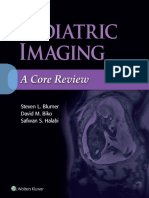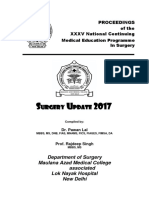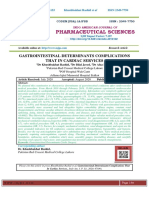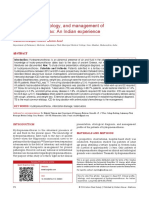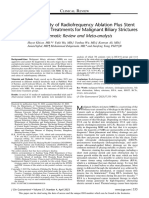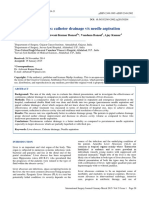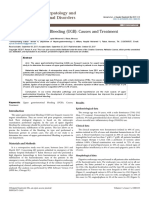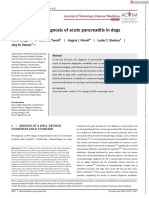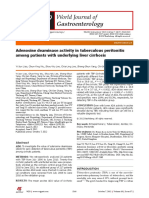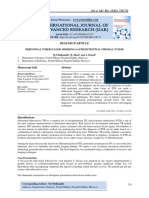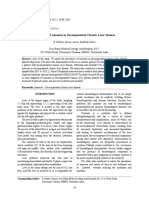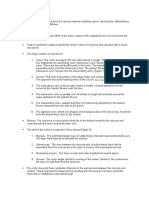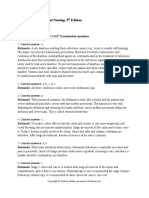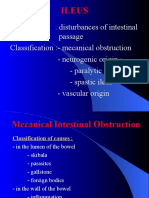Professional Documents
Culture Documents
Hepatic Portovenous Gas in A Young Male
Hepatic Portovenous Gas in A Young Male
Original Title
Copyright
Available Formats
Share this document
Did you find this document useful?
Is this content inappropriate?
Report this DocumentCopyright:
Available Formats
Hepatic Portovenous Gas in A Young Male
Hepatic Portovenous Gas in A Young Male
Copyright:
Available Formats
Volume 9, Issue 4, April – 2024 International Journal of Innovative Science and Research Technology
ISSN No:-2456-2165 https://doi.org/10.38124/ijisrt/IJISRT24APR764
Hepatic Portovenous Gas in a Young Male
T. Rama Rao*1; R. Srujana2; Rabia Basri2; J. Namratha2
*1
Professor and Principal, CMR College of Pharmacy, Hyderabad, Telangana, India
2
Department of Pharm. D, CMR College of Pharmacy, Hyderabad, Telangana, India
Corresponding Author’s Address:
Tadikonda Rama Rao
Professor and Principal
CMR College of Pharmacy,
Kandlakoya(V), Medchal Road,
Telangana -501401
Abstract:- Hepatic portal venous gas is diagnosed via II. CASE STUDY
computed tomography due to unusual imaging features.
Hepatic portal venous gas when linked with pneumatosis A 35 year-old male patient came via ambulance to the
intestinalis has a high mortality rate and required urgent emergency department with a 12 hour history of generalised
intervention. We present a case of a 35 year-old male abdominal pain, watery diarrhoea and vomiting. He had a
patient with a 12 hour history of generalised abdominal background of gout and alcoholism. The patient denied
pain, watery diarrhoea and vomiting. He had a abusing drugs when questioned further. He had an
background of gout and alcoholism. He had an unmeasurable blood pressure and sinus tachycardia when he
unmeasurable blood pressure and sinus tachycardia was first seen. A physical examination found that his right
when he was first seen. The patient was stabilized after side of the abdomen was stiff. With a lactate level of 15,
undergoing vigorous intravenous fluid resuscitation, and venous blood gas analysis showed a severe anion gap
he was then sent for a CT scan. A considerable amount metabolic acidosis; a complete blood count revealed
of hepatic portovenous gas was seen on the CT scan, neutrophilia. Elevated lipase levels were observed along
coupled with dilated and diffusely aberrant small and with abnormalities in liver function tests. The patient was
large bowel with mucosal enhancement. stabilized after undergoing vigorous intravenous fluid
resuscitation, and he was then sent for a CT scan. A
Keywords:- Hepatic Portal Venous Gas, Enterocolitis, Small considerable amount of hepatic portovenous gas (HPVG)
Bowel Obstruction, Subserosal, Submucosal. was seen on the CT scan, coupled with dilated and diffusely
aberrant small and large bowel with mucosal enhancement.
I. INTRODUCTION Significant stranding around the external iliac and common
femoral arteries was also noted indicating diffuse bowel
Hepatic portal venous gas (HPVG) is a medical illness ischemia. Sadly, the patient passed away before being
that affects the portal venous system and its branches. moved from emergency room, despite the surgery team
Clinical signs of HPVG might range from mild disorders to plans to perform an exploratory laparotomy. Without a
serious illnesses[1]. HPVG was first reported as a finding in discernible underlying cause, a post-mortem investigation
new-borns with necrotizing enterocolitis. Since then, it has demonstrated indications of acute small intestinal ischemia.
been linked to a number of underlying abdominal ailments, One theory was that the reason could have been mechanical,
ranging from benign conditions to potentially fatal like a tiny bowel volvulus that resolved on its own.
conditions needing emergency surgery[2]. When HPVG is
diagnosed, it might indicate a number of underlying clinical
disorders, from benign etiologies to serious illnesses
requiring emergency surgery[3].
The diagnosis of HPVG implies various underlying
clinical conditions, ranging from benign etiologiesto severe
clinical conditions that need immediate surgical treatment.
IJISRT24APR764 www.ijisrt.com 711
Volume 9, Issue 4, April – 2024 International Journal of Innovative Science and Research Technology
ISSN No:-2456-2165 https://doi.org/10.38124/ijisrt/IJISRT24APR764
[2]. Mubarik, Ateeq MD1; Siddiqui, Salaah DO1; Iqbal,
Arshad Muhammad MD1; Mohammed, Sohaib
Khaleel MD2; Muddassir, Salman MD1; Eddib,
Abdulmagid MD1; Herraka, Ihab MD3. Iatrogenic
Hepatic portal venous gas in a patient with crohn's
disease after colonoscopy. ACG Case Reports Journal
6(8): p e00150, August 2019. | DOI:
10.14309/crj.0000000000000150
[3]. Kim HJ, Kim HK. Idiopathic hepatic portal venous gas
in a healthy young man. Int J Gen Med. 2020;13:687‐
692. doi: 10.2147/IJGM.S276438 [PMC free
article] [PubMed] [CrossRef] [Google Scholar]
[4]. Sisk PB. Gas in the portal venous system. Radiology
1961;77(1):103–7. |Google Scholar
[5]. Cunningham G, Cameron G, De Cruz P. Hepatic portal
venous gas in Crohn's disease. BMJ Case Rep.
2014;2014:bcr2014206244. |Google Scholar
Fig 1: Plain Radiographs of the Chest (A) and Abdomen (B) [6]. Wang M, Song J, Gong S, Yu Y, Hu W, Wang
Displaying Hepatic Portal Venous Gas (Arrow Head) and Y. Hepatic portal venous gas with pneumatosis
Subphrenic Free Air (White Arrow). intestinalis secondary to mesenteric ischemia in elderly
patients: two case reports. Medicine (Baltimore).
III. DISCUSSION AND CONCLUSION 2020;99(17):e19810. doi:
10.1097/MD.0000000000019810 [PMC free
The literature refers to HPVG as gas embolization of article] [PubMed] [CrossRef] [Google Scholar]
the portal venous circulation. Bowel necrosis (72%), [7]. Ito M, Horiguchi A, Miyakawa S. Pneumatosis
ulcerative colitis (8%), intra-abdominal abscess (6%), small intestinalis and hepatic portal venous gas. J
bowel obstruction (3%), and gastric ulcers (3%), are also Hepatobiliary Pancreat Surg. 2008;15(3):334‐337.
frequently linked to HPVG. We are presenting HPVG as an doi: 10.1007/s00534-007-1246-1 [PubMed]
uncommon but well-known Crohn's disease consequence, as [CrossRef] [Google Scholar]
it is shown in the case. About 58% of HPVG cases linked to [8]. Liebman PR, Patten MT, Manny J, Benfield
Crohn's disease are iatrogenic, meaning they resulted from JR, Hechtman HB. Hepatic-portal venous gas in adults:
blunt abdominal trauma, barium enema studies, or Etiology, pathophysiology and clinical
colonoscopies[4, 5]. Three potential mechanisms of HPVG are significance. Annals of Surgery 1978; 187: 281–7.
mucosal injury, intestinal distension, and sepsis brought on [9]. Vleggaar FP, van Buuren HR, Schalm SW. Endoscopic
by gas-forming bacteria. Of the patients with hepatic portal sclerotherapy for bleeding esophagogastric varices
venous gas, over two-thirds had a necrotic gut. Gas-filled secondary to extrahepatic portal venous obstruction in
subserosal and submucosal cysts in the digestive system, an adult population. Eur J Gastroenterol Heptaol
known as pneumatosis intestinalis (PI), are often 1998;10:81–5.
accompanied with gas in the hepatic portal vein [6, 7]. Simple
abdominal X-rays can show branching radiolucencies that
extend to within 2 cm of the hepatic capsule, which is
indicative of hepatic PVG. They are most useful in revealing
PVG when the patient is in the left lateral decubitus posture
[8]
. Treatment for varices secondary to PVT involves
endoscopic elimination with VBL, beta-blockers, and
nitrates, and is comparable to methods for varices from other
portal hypertension mechanisms. According to one study,
these procedures are very effective and low risk; it shows a
95% 5-year survival rate and no mortality from recurrent
bleeding in cases of extrahepatic portal vein obstruction. [9]
REFERENCES
[1]. Dhakal P, Sharma S, Sharma A, Pandey S, Aryal S,
Bhnadari S. Hepatic portal venous gas in the case of
superior mesenteric artery thrombosis in a young adult-
case report. Clin Case Rep. 2023 Feb 24;11(2):e6989.
doi: 10.1002/ccr3.6989. PMID: 36852123; PMCID:
PMC9957697.
IJISRT24APR764 www.ijisrt.com 712
You might also like
- Black S Medical Dictionary PDFDocument2,413 pagesBlack S Medical Dictionary PDFAlexandr Trotsky100% (1)
- Practical Prescriber PDFDocument515 pagesPractical Prescriber PDFGandhi Lanka100% (2)
- Pediatric Imaging A Core Review PDFDocument767 pagesPediatric Imaging A Core Review PDFBeatriz100% (3)
- Introduction To Pediatric Radiology Pediatric Radiology Online Course by Dr. Ashraf Abotaleb PDFDocument436 pagesIntroduction To Pediatric Radiology Pediatric Radiology Online Course by Dr. Ashraf Abotaleb PDFRicardo VallejoNo ratings yet
- Mamc Update 2017Document366 pagesMamc Update 2017Anwesa Chakraborty0% (1)
- How To Perform Gastrointestinal Ultrasound AnatomyDocument17 pagesHow To Perform Gastrointestinal Ultrasound AnatomyElisabeth PermatasariNo ratings yet
- Jerry L. Tennant - What Works - SCENAR Certification Training Seminar (2004)Document229 pagesJerry L. Tennant - What Works - SCENAR Certification Training Seminar (2004)Ramesh Singh100% (4)
- Pediatric Surgery PresentationDocument191 pagesPediatric Surgery PresentationdanoonotNo ratings yet
- Clinical Profile Etiology and Management of HydropDocument3 pagesClinical Profile Etiology and Management of HydropRahma WatiNo ratings yet
- Sciencedomain, Sakharkar3352A2021JPRI72980Document5 pagesSciencedomain, Sakharkar3352A2021JPRI72980Eya BaldostamonNo ratings yet
- Article 1615981002 PDFDocument3 pagesArticle 1615981002 PDFMaria Lyn Ocariza ArandiaNo ratings yet
- Case Report: Reynolds SyndromeDocument2 pagesCase Report: Reynolds SyndromePeertechz Publications Inc.No ratings yet
- Impact of CT Imaging On Predicting The Surgical Management of Acute DiverticulitisDocument8 pagesImpact of CT Imaging On Predicting The Surgical Management of Acute DiverticulitisГне ДзжNo ratings yet
- Management of Ruptured Liver Abscess: A Study of 54 CasesDocument4 pagesManagement of Ruptured Liver Abscess: A Study of 54 CasesIndah FebrianaNo ratings yet
- A Study of Clinical Presentations and Management oDocument4 pagesA Study of Clinical Presentations and Management oMaria AkulinaNo ratings yet
- Pharmaceutical Sciences: Gastrointestinal Determinants Complications That in Cardiac ServicesDocument6 pagesPharmaceutical Sciences: Gastrointestinal Determinants Complications That in Cardiac ServicesiajpsNo ratings yet
- Liver A BSC DrainDocument8 pagesLiver A BSC DrainAngelica AmesquitaNo ratings yet
- tmpC401 TMPDocument3 pagestmpC401 TMPFrontiersNo ratings yet
- General Surgery: Ruptured Liver Abscess: A Novel Surgical TechniqueDocument3 pagesGeneral Surgery: Ruptured Liver Abscess: A Novel Surgical TechniqueRahul SinghNo ratings yet
- Gastrite Enfisematosa - InglêsDocument7 pagesGastrite Enfisematosa - Inglêsamanda.gomesNo ratings yet
- Journal Pre-Proof: Clinical ImagingDocument31 pagesJournal Pre-Proof: Clinical ImagingMohammed Shuaib AhmedNo ratings yet
- Posthepatectomy Liver Failure: A Definition and Grading by The International Study Group of Liver Surgery (ISGLS)Document12 pagesPosthepatectomy Liver Failure: A Definition and Grading by The International Study Group of Liver Surgery (ISGLS)drsubramanianNo ratings yet
- Serosal Appendicitis: Incidence, Causes and Clinical SignificanceDocument3 pagesSerosal Appendicitis: Incidence, Causes and Clinical SignificancenaufalrosarNo ratings yet
- Rheumatic Manifestations of Inflammatory Bowel Diseases: A Study From The Middle EastDocument11 pagesRheumatic Manifestations of Inflammatory Bowel Diseases: A Study From The Middle EastAndreiMunteanuNo ratings yet
- Abcesele FicatuluiDocument4 pagesAbcesele FicatuluiMihaela AlinaNo ratings yet
- A Tertiary Care Hospital's Comparison of Hydronephrosis in An Adult and A Rare CauseDocument4 pagesA Tertiary Care Hospital's Comparison of Hydronephrosis in An Adult and A Rare CauseInternational Journal of Innovative Science and Research TechnologyNo ratings yet
- Primary Pancreatic Hydatid Cyst: A Case Report and Literature ReviewDocument6 pagesPrimary Pancreatic Hydatid Cyst: A Case Report and Literature ReviewNatalindah Jokiem Woecandra T. D.No ratings yet
- Endoscopia en HDADocument10 pagesEndoscopia en HDASMIBA MedicinaNo ratings yet
- Flu I Do Pneumo Thorak SDocument3 pagesFlu I Do Pneumo Thorak SrahayuNo ratings yet
- Overlap Syndrome of Autoimmune Hepatitis and Primary Biliary Cirrhosis: A Clinical EnigmaDocument6 pagesOverlap Syndrome of Autoimmune Hepatitis and Primary Biliary Cirrhosis: A Clinical EnigmaCristian CozmaNo ratings yet
- Adler 2015Document7 pagesAdler 2015nathaliepichardoNo ratings yet
- Meta 6 - Khizar - 2023Document11 pagesMeta 6 - Khizar - 2023matheus.verasNo ratings yet
- Ren 2020 Alteraciones MicrobiotaDocument14 pagesRen 2020 Alteraciones MicrobiotaMartin GomezNo ratings yet
- Abses Adalah 1332 5211 1 PBDocument5 pagesAbses Adalah 1332 5211 1 PBSayhelloTVNo ratings yet
- Article LCA Mars 2023Document10 pagesArticle LCA Mars 2023Côme JaubertNo ratings yet
- Journal No.1 (Nov 1)Document6 pagesJournal No.1 (Nov 1)Ronel ResurricionNo ratings yet
- Liver Abscess: Catheter Drainage V/s Needle AspirationDocument6 pagesLiver Abscess: Catheter Drainage V/s Needle AspirationMishel Rodriguez GuzmanNo ratings yet
- CORRIGENDUM TO Immunosuppression in Liver - 2022 - Best Practice - Research CliDocument3 pagesCORRIGENDUM TO Immunosuppression in Liver - 2022 - Best Practice - Research CliJuan Mendia OssioNo ratings yet
- Procalcitonin Is It The End of Road To Sepsis Diagnosis - February - 2022 - 6546541022 - 2629943Document2 pagesProcalcitonin Is It The End of Road To Sepsis Diagnosis - February - 2022 - 6546541022 - 2629943RateeshNo ratings yet
- Quality Indicators For Esophagogastroduodenoscopy: ASGE/ACG Taskforce On Quality in EndosDocument6 pagesQuality Indicators For Esophagogastroduodenoscopy: ASGE/ACG Taskforce On Quality in EndosMario A Herrera CortésNo ratings yet
- Upper Gastrointestinal Bleeding Ugb Causes and Treatment 2475 3181 1000153Document3 pagesUpper Gastrointestinal Bleeding Ugb Causes and Treatment 2475 3181 1000153Envhy AmaliaNo ratings yet
- Case 37-2020: A 35-Year-Old Man With Lymphadenopathy and PetechiaeDocument11 pagesCase 37-2020: A 35-Year-Old Man With Lymphadenopathy and PetechiaePatriciaNo ratings yet
- Neumonia Asociado A Servicios de La SaludDocument7 pagesNeumonia Asociado A Servicios de La SaludOscarNo ratings yet
- Is Primary Sclerosing Cholangitis With Inflammatory Bowel Disease Different Between Patients in The East and West?Document2 pagesIs Primary Sclerosing Cholangitis With Inflammatory Bowel Disease Different Between Patients in The East and West?RobertVellaZammitNo ratings yet
- Acute Pyelonephritis in Adults: A Case Series of 223 PatientsDocument6 pagesAcute Pyelonephritis in Adults: A Case Series of 223 PatientsshiaNo ratings yet
- A Case of Pelvic and Right Iliac Fossa Abscess: A Diagnostic DilemmaDocument2 pagesA Case of Pelvic and Right Iliac Fossa Abscess: A Diagnostic DilemmaInternational Journal of Innovative Science and Research TechnologyNo ratings yet
- Atypical Presentation of Genital ChlamydiaDocument5 pagesAtypical Presentation of Genital ChlamydiaIJAR JOURNALNo ratings yet
- A Guide To The Management of Tuberculosis in Patients With Chronic Liver DiseaseDocument12 pagesA Guide To The Management of Tuberculosis in Patients With Chronic Liver DiseaseMeldaNo ratings yet
- Advances in The Diagnosis of Acute Pancreatitis in DogsDocument16 pagesAdvances in The Diagnosis of Acute Pancreatitis in DogsRoberto Gutiérrez GonzálezNo ratings yet
- Liver Abscess DissertationDocument4 pagesLiver Abscess DissertationPayForAPaperAtlanta100% (1)
- Diagnosis and Management of Klatskin Tumor: April 2010Document6 pagesDiagnosis and Management of Klatskin Tumor: April 2010Feby Kurnia PutriNo ratings yet
- Gastroenterology: World Journal ofDocument13 pagesGastroenterology: World Journal ofdrcafemanNo ratings yet
- BVBVDocument11 pagesBVBVŽeljko ĐurićNo ratings yet
- Hepatic Sarcoidosis Presenting As Portal Hypertension and Liver Cirrhosis: Case Report and Review of The LiteratureDocument7 pagesHepatic Sarcoidosis Presenting As Portal Hypertension and Liver Cirrhosis: Case Report and Review of The LiteratureMelody PardilloNo ratings yet
- Absceso Hepatico 2Document7 pagesAbsceso Hepatico 2Astrid MendezNo ratings yet
- Obs Jaundice AcceptedDocument8 pagesObs Jaundice AcceptedNovita ApramadhaNo ratings yet
- Adenosine Deaminase Activity in Tuberculous Peritonitis Among Patients With Underlying Liver CirrhosisDocument6 pagesAdenosine Deaminase Activity in Tuberculous Peritonitis Among Patients With Underlying Liver Cirrhosisgustina mariantiNo ratings yet
- Peritoneal Tuberculosis Mimiking Gastrointestinal Stromal TumorDocument3 pagesPeritoneal Tuberculosis Mimiking Gastrointestinal Stromal TumorIJAR JOURNALNo ratings yet
- Gastroenterology: World Journal ofDocument18 pagesGastroenterology: World Journal ofHana Nuraisa BasyaNo ratings yet
- Wjge 11 438Document6 pagesWjge 11 438GEOFANY HARGI FINDAWANNo ratings yet
- 2014 Article 639Document8 pages2014 Article 639Anida HasnaNo ratings yet
- WarshawDocument11 pagesWarshawJuan RamirezNo ratings yet
- Management Guidelines For Gallstone Pancreatitis ADocument6 pagesManagement Guidelines For Gallstone Pancreatitis AkartikapuspitNo ratings yet
- Prevalence of Anaemia in Decompensated Chronic Liver DiseaseDocument5 pagesPrevalence of Anaemia in Decompensated Chronic Liver DiseaseElang SudewaNo ratings yet
- Gallbladder Perforation: Experience of 35 Cases at A Tertiary Care HospitalDocument6 pagesGallbladder Perforation: Experience of 35 Cases at A Tertiary Care HospitalIJAR JOURNALNo ratings yet
- GI Surgery Annual: Volume 25From EverandGI Surgery Annual: Volume 25Peush SahniNo ratings yet
- The Liver Graft Before Transplantation: Defining Outcome After Liver TransplantationFrom EverandThe Liver Graft Before Transplantation: Defining Outcome After Liver TransplantationXavier VerhelstNo ratings yet
- Conceptualized Fusion Reactor based on Gas Turbine with High Temperature CO2Document7 pagesConceptualized Fusion Reactor based on Gas Turbine with High Temperature CO2International Journal of Innovative Science and Research TechnologyNo ratings yet
- Human Resource Functions: Examining Insights from ABC Research OrganizationDocument9 pagesHuman Resource Functions: Examining Insights from ABC Research OrganizationInternational Journal of Innovative Science and Research TechnologyNo ratings yet
- The Impact of Termite Activity on the Availability of Soil Micronutrients in Tropical RegionsDocument6 pagesThe Impact of Termite Activity on the Availability of Soil Micronutrients in Tropical RegionsInternational Journal of Innovative Science and Research Technology100% (1)
- Teacher-Induced Academic Stress: Predicting Eating Behavior Problems in College StudentsDocument8 pagesTeacher-Induced Academic Stress: Predicting Eating Behavior Problems in College StudentsInternational Journal of Innovative Science and Research TechnologyNo ratings yet
- The Impact of the Commercial Agriculture Credit Scheme (CACS) on the Agricultural Economy of Nigeria and its Total Output (2015-2019)Document8 pagesThe Impact of the Commercial Agriculture Credit Scheme (CACS) on the Agricultural Economy of Nigeria and its Total Output (2015-2019)International Journal of Innovative Science and Research TechnologyNo ratings yet
- The Expanding Attack Surface: Securing AI and Machine Learning Systems in Security OperationsDocument8 pagesThe Expanding Attack Surface: Securing AI and Machine Learning Systems in Security OperationsInternational Journal of Innovative Science and Research Technology100% (1)
- Study of prevalence of Head Lice (Pediculus Humanus Capitis) Among Schoolchildren in the Zawiya Region, LibyaDocument10 pagesStudy of prevalence of Head Lice (Pediculus Humanus Capitis) Among Schoolchildren in the Zawiya Region, LibyaInternational Journal of Innovative Science and Research Technology0% (1)
- Utilizing Chicken Eggshells and Waste Glass Powder as Cement Fillers for Environmental StabilityDocument6 pagesUtilizing Chicken Eggshells and Waste Glass Powder as Cement Fillers for Environmental StabilityInternational Journal of Innovative Science and Research TechnologyNo ratings yet
- The Influence of Continuance Commitment on Job Satisfaction of Barangay Health Workers in Malaybalay City, BukidnonDocument14 pagesThe Influence of Continuance Commitment on Job Satisfaction of Barangay Health Workers in Malaybalay City, BukidnonInternational Journal of Innovative Science and Research TechnologyNo ratings yet
- Modern Approaches to Sustainable AgricultureDocument10 pagesModern Approaches to Sustainable AgricultureInternational Journal of Innovative Science and Research Technology100% (1)
- Assessment of Integrated Poultry Manure and Synthetic Fertilizer Effects on Maize (Zea mays) Growth and Soil Properties: A Study from Bayero University, KanoDocument15 pagesAssessment of Integrated Poultry Manure and Synthetic Fertilizer Effects on Maize (Zea mays) Growth and Soil Properties: A Study from Bayero University, KanoInternational Journal of Innovative Science and Research Technology100% (1)
- Integrating Quantum Algorithms with Gravitational-Wave Metrology for Enhanced Signal DetectionDocument18 pagesIntegrating Quantum Algorithms with Gravitational-Wave Metrology for Enhanced Signal DetectionInternational Journal of Innovative Science and Research Technology100% (1)
- Intelligent Clinical Documentation: Harnessing Generative AI For Patient-Centric Clinical Note GenerationDocument15 pagesIntelligent Clinical Documentation: Harnessing Generative AI For Patient-Centric Clinical Note GenerationInternational Journal of Innovative Science and Research TechnologyNo ratings yet
- Meta Land: Redefining Virtual Communities Through Centralized Governance, Inclusivity and InnovationDocument5 pagesMeta Land: Redefining Virtual Communities Through Centralized Governance, Inclusivity and InnovationInternational Journal of Innovative Science and Research TechnologyNo ratings yet
- Transforming Challenges to Victories: An Inquiry on Transformational Leadership of School Leaders in the Public Elementary SchoolsDocument54 pagesTransforming Challenges to Victories: An Inquiry on Transformational Leadership of School Leaders in the Public Elementary SchoolsInternational Journal of Innovative Science and Research TechnologyNo ratings yet
- Unlocking Sentiments: Enhancing IOCL Petrol Pump ExperiencesDocument8 pagesUnlocking Sentiments: Enhancing IOCL Petrol Pump ExperiencesInternational Journal of Innovative Science and Research TechnologyNo ratings yet
- Personal Capabilities of The Non-Teaching Personnel and Client SatisfactionDocument8 pagesPersonal Capabilities of The Non-Teaching Personnel and Client SatisfactionInternational Journal of Innovative Science and Research TechnologyNo ratings yet
- Exploring The Potential Advantages of Traditional Therapies in Autoimmune Blistering Illnesses: A Comprehensive Review and Analysis, ResearchDocument12 pagesExploring The Potential Advantages of Traditional Therapies in Autoimmune Blistering Illnesses: A Comprehensive Review and Analysis, ResearchInternational Journal of Innovative Science and Research TechnologyNo ratings yet
- Skin Disease Detection and Remedial SystemDocument7 pagesSkin Disease Detection and Remedial SystemInternational Journal of Innovative Science and Research TechnologyNo ratings yet
- Solar Based Multilevel Inverter F o R BLDC Motor DriveDocument8 pagesSolar Based Multilevel Inverter F o R BLDC Motor DriveInternational Journal of Innovative Science and Research TechnologyNo ratings yet
- Seasonal Variation and Distribution Patterns of Endophytic Community in Withania SomniferaDocument7 pagesSeasonal Variation and Distribution Patterns of Endophytic Community in Withania SomniferaInternational Journal of Innovative Science and Research TechnologyNo ratings yet
- Fall Detection and Boundary Detection in Care HomesDocument7 pagesFall Detection and Boundary Detection in Care HomesInternational Journal of Innovative Science and Research TechnologyNo ratings yet
- Development of Smart Ground Fault Location Model For Radial Distribution SystemDocument14 pagesDevelopment of Smart Ground Fault Location Model For Radial Distribution SystemInternational Journal of Innovative Science and Research TechnologyNo ratings yet
- Design and Development of Multi-Featured Medical StretcherDocument4 pagesDesign and Development of Multi-Featured Medical StretcherInternational Journal of Innovative Science and Research TechnologyNo ratings yet
- Strategic Deployment of Ducklink Wireless Devices For Disaster Mitigation and Management in Nueva ECIJA University of Science and Technology Sumacab CampusDocument13 pagesStrategic Deployment of Ducklink Wireless Devices For Disaster Mitigation and Management in Nueva ECIJA University of Science and Technology Sumacab CampusInternational Journal of Innovative Science and Research TechnologyNo ratings yet
- EmoConnect: Nurturing Trust and Relationship Bonds in Alzheimer's ConversationsDocument3 pagesEmoConnect: Nurturing Trust and Relationship Bonds in Alzheimer's ConversationsInternational Journal of Innovative Science and Research TechnologyNo ratings yet
- Preparation and Identification of Magnetic Iron Nanoparticle Based On A Natural Hydrogel and Its Performance in Targeted Drug DeliveryDocument17 pagesPreparation and Identification of Magnetic Iron Nanoparticle Based On A Natural Hydrogel and Its Performance in Targeted Drug DeliveryInternational Journal of Innovative Science and Research TechnologyNo ratings yet
- Application of Plant Growth Promoting Rhizobacteria On Vegetative Growth in Chili Plants (Capsicum Frutescens L.)Document7 pagesApplication of Plant Growth Promoting Rhizobacteria On Vegetative Growth in Chili Plants (Capsicum Frutescens L.)International Journal of Innovative Science and Research TechnologyNo ratings yet
- Smart and Secure Home With ChatbotDocument9 pagesSmart and Secure Home With ChatbotInternational Journal of Innovative Science and Research TechnologyNo ratings yet
- Reading Intervention Through "Brigada Sa Pagbasa": Viewpoint of Primary Grade TeachersDocument3 pagesReading Intervention Through "Brigada Sa Pagbasa": Viewpoint of Primary Grade TeachersInternational Journal of Innovative Science and Research TechnologyNo ratings yet
- Diverticular DiseaseDocument15 pagesDiverticular DiseaseRogie SaludoNo ratings yet
- Intestinal Malrotation - A Common Yet Deadly Cause of Neonatal Small Bowel ObstructionDocument4 pagesIntestinal Malrotation - A Common Yet Deadly Cause of Neonatal Small Bowel ObstructionIJAR JOURNALNo ratings yet
- Imaging in Acute Abdomen: Dr. Wan Najwa Zaini Wan Mohamed Radiologist, Hospital Queen Elizabeth IiDocument70 pagesImaging in Acute Abdomen: Dr. Wan Najwa Zaini Wan Mohamed Radiologist, Hospital Queen Elizabeth IiYogi drNo ratings yet
- Acute Abdomen - SabistonDocument24 pagesAcute Abdomen - Sabiston2013SecB100% (1)
- Bove 2012 Visc Mobiliz Adhesion RatDocument7 pagesBove 2012 Visc Mobiliz Adhesion RatQuiroprácticaParaTodosNo ratings yet
- Surgery Final Year SyllabusDocument6 pagesSurgery Final Year SyllabusMariam NadeemNo ratings yet
- ColectomyDocument12 pagesColectomyNarita Ekananda Agesta RaswitaNo ratings yet
- Case Scenario - Student Abdomen Hoffman, V-2Document5 pagesCase Scenario - Student Abdomen Hoffman, V-2Rebekah HNo ratings yet
- Jurnal KDPDocument5 pagesJurnal KDPRAIHAN ANUGRAHNo ratings yet
- Acute AbdomenDocument29 pagesAcute AbdomenUmar AzlanNo ratings yet
- CASE 28 Recurrent Abdominal PainDocument5 pagesCASE 28 Recurrent Abdominal PainRoseNo ratings yet
- Abdominal Pain MARS 2.0 - Dr. Siswidiyati, SP - RadDocument34 pagesAbdominal Pain MARS 2.0 - Dr. Siswidiyati, SP - RadarifdeathsciethNo ratings yet
- Lewis: Medical-Surgical Nursing, 9 EditionDocument2 pagesLewis: Medical-Surgical Nursing, 9 EditionSLNo ratings yet
- Duty Report 10 August 2016 EditedDocument5 pagesDuty Report 10 August 2016 EditedbloodsphereNo ratings yet
- SURGERY PRETEST QUESTIONS I - Dr. MARIANA UNGUR - Second Semester - General Surgery 4th YearDocument7 pagesSURGERY PRETEST QUESTIONS I - Dr. MARIANA UNGUR - Second Semester - General Surgery 4th YearMariana UngurNo ratings yet
- Abdominal ImagingDocument124 pagesAbdominal ImagingLaichenaNo ratings yet
- H ': P P C N - GCNC: Irschsprung S Disease Re and Ostoperative Are in EonatesDocument12 pagesH ': P P C N - GCNC: Irschsprung S Disease Re and Ostoperative Are in EonatesAnonymous 18GsyXbNo ratings yet
- Second FridayDocument6 pagesSecond FridaymrashaiedehNo ratings yet
- ILEUS.,,... Kuliah Internasional Prof MTDocument10 pagesILEUS.,,... Kuliah Internasional Prof MTtatadhNo ratings yet
- Intestinal Obstruction, Colorectal CancerDocument49 pagesIntestinal Obstruction, Colorectal CancermeghanaNo ratings yet
- final exam 2017 ER (sami) ٢Document17 pagesfinal exam 2017 ER (sami) ٢Dr. MLKNo ratings yet
- CompilationDocument14 pagesCompilationSylph AngeliqueNo ratings yet
- Care Study 1-5 CorrectionsDocument69 pagesCare Study 1-5 CorrectionsAfricaTeddyNo ratings yet


